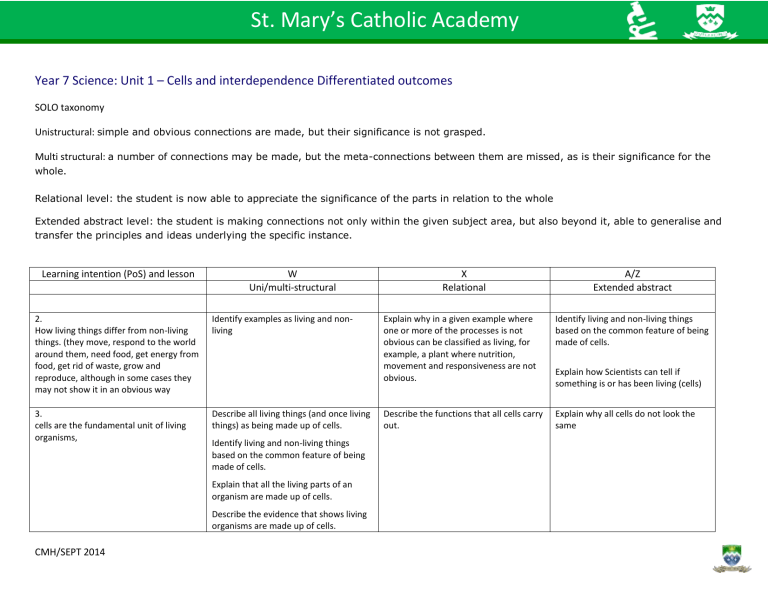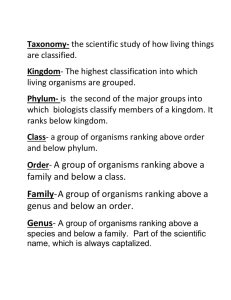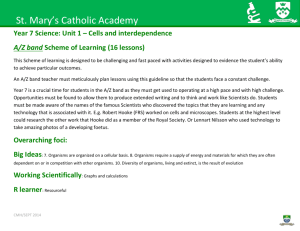Year 7 Cells – Scheme of Learning Using SOLO

St. Mary’s Catholic Academy
Year 7 Science: Unit 1 – Cells and interdependence Differentiated outcomes
SOLO taxonomy
Unistructural:
simple and obvious connections are made, but their significance is not grasped.
Multi structural:
a number of connections may be made, but the meta-connections between them are missed, as is their significance for the whole.
Relational level: the student is now able to appreciate the significance of the parts in relation to the whole
Extended abstract level: the student is making connections not only within the given subject area, but also beyond it, able to generalise and transfer the principles and ideas underlying the specific instance.
Learning intention (PoS) and lesson
2.
How living things differ from non-living things. (they move, respond to the world around them, need food, get energy from food, get rid of waste, grow and reproduce, although in some cases they may not show it in an obvious way
3. cells are the fundamental unit of living organisms,
W
Uni/multi-structural
Identify examples as living and nonliving
Describe all living things (and once living things) as being made up of cells.
Identify living and non-living things based on the common feature of being made of cells.
Explain that all the living parts of an organism are made up of cells.
Describe the evidence that shows living organisms are made up of cells.
CMH/SEPT 2014
X
Relational
Explain why in a given example where one or more of the processes is not obvious can be classified as living, for example, a plant where nutrition, movement and responsiveness are not obvious.
A/Z
Extended abstract
Identify living and non-living things based on the common feature of being made of cells.
Explain how Scientists can tell if something is or has been living (cells)
Describe the functions that all cells carry out.
Explain why all cells do not look the same
St. Mary’s Catholic Academy
4. including how to observe, interpret and record cell structure using a light microscope
5.
The similarities between plant and animal cells
Correctly set up a microscope to view a slide successfully and safely.
Describe how to safely use a microscope.
Draw an image they have observed using a microscope.
Explain why a microscope must be used to view cells.
Describe the typical animal and plant cell models.
Describe that most animal cells have a nucleus, cytoplasm and cell membrane.
Describe that plant cells have a nucleus, cytoplasm, cell membrane, cell wall, vacuole and, in green cells, chloroplasts.
Identify a typical cell as being 3-D.
Make the shape of a typical cell as 3-D.
Give examples of cells that show there is a variety of different size and shape cells.
Estimate the size of very small objects.
Make a slide.
Explain why plant cells have chloroplasts and cell walls.
Explain how Scientists can use different lenses to produce more and less magnified images
Calculate actual size from a microscopic image
Explain why cells have a vacuole
Compare and contrast animals and plants explaining why they need to have different cell organelle.
6. the functions of the cell wall, cell membrane, cytoplasm, nucleus, vacuole, mitochondria and chloroplasts the role of diffusion in the movement of materials in and between cells
State the components of the cell that perform specific functions.
Match the components with their functions.
Identify the characteristic features that nearly all cells share – membrane, cytoplasm and nucleus.
Identify chemicals that need to go into cells and chemicals that need to leave cells.
Describe the specific functions that the components of the cell perform.
Name and describe some examples of specialised cells.
Explain how chemicals can move in and out of cells.
Explain how they are specialised to carry out their specific functions.
Explain the term diffusion
CMH/SEPT 2014
St. Mary’s Catholic Academy
7. the structural adaptations of some unicellular organisms the heirarchical organisation of multicellular organisms; from cells to tissues to organisms
9. reproduction in humans, including the structure and function of the male and female reproductive systems,
10. menstrual cycles, gametes, fertilisation, gestation and birth, to include the effect of maternal lifestyle on the foetus through the placenta
11. reproduction in plants, including flower structure, wind and insect pollination, fertilisation, seed and fruit formation and dispersal, including quantitative investigation of some dispersal mechanisms the importance of plant reproduction through insect pollination in human food security
12. KS2
13. the interdependence of organisms in an ecosystem, including food webs and
CMH/SEPT 2014
Identify a unicellular organism - when presented with a range of organisms classify each as either a unicellular or a multicellular organism.
Identify ways in which it is different to a multicellular organism cell
Describe a tissue as a collection of similar cells
Identify organs in the human body
Identify ways in which a unicellular cell is different to a multicellular organism cell
Explain how we know that all living things are made up of cells, from a single cell to many millions of cells.
Identify and name the reproductive cells and organs
Describe fertilization as the fusion of egg and sperm
Describe the changes in the uterus throughout the menstrual cycle
Identify the importance of the placenta in supplying food for the developing foetus
Identify activities that the mother can do that may harm her unborn baby
Describe some stages of foetal development
Identify plant sex cells and their location
Describe how fertilization occurs in plants through insect pollination and seed dispersal
Describe the functions of the reproductive organs
Describe fertilization as the fusion of 2 cell nuclei
Describe egg and sperm cells
Explain how the foetus obtains the materials it needs for growth
Describe the changes that occur during the menstrual cycle
Describe the structure of a plant
Describe adaptations of a plant and explain how this helps plant reproduction
Describe structural adaptations of unicellular organisms e.g. Bacteria DNA not in nucleus so they can reproduce faster
Explain how egg and sperm are specialized
Describe how they carry information for the development of new life
Explain how the foetus obtains the materials it needs for growth
Explain why activities of mother can affect an unborn child
Explain the importance of plant reproduction through insect pollination in terms of human food security
Describe how organisms within a habitat compete for resources.
Identify the effect of change in population of one organism on an
To explain how all organisms in a food web are effected by the change in
St. Mary’s Catholic Academy insect pollinated crops
14. how organisms affect, and are affected by, their environment, including the accumulation of toxic materials
Explain how energy is transferred through a food web.
To explain how organisms within a habitat can be linked together in food chains/food webs.
To explain how population numbers can change over time, as a result of both seasonal changes and predator/prey relationships
Identify that energy flows through a food chain
Identify adaptations of organisms within an ecosystem and explain how it helps them to survive ecosystem
Describe the effect of change in insect population on the interdependence of organisms
Explain how toxic materials might spread through the organisms within an ecosystem population of an organism
Explain why the amount of energy passed on at each trophic level decreases
Explain why the amount of energy passed on at each trophic level decreases
Explain what is meant by bioaccumulation









